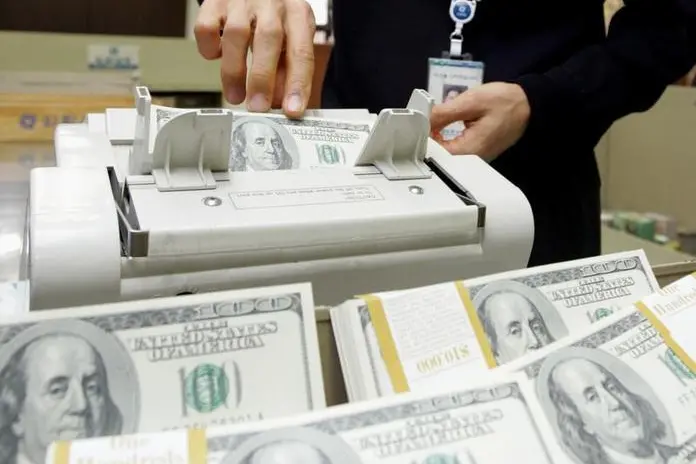PHOTO
(The opinions expressed here are those of the author, a columnist for Reuters)
ORLANDO - For all the hullabaloo about the world weaning itself off the U.S. dollar, hard numbers show that both central banks and private sector institutions continue to increase their holdings of dollar-denominated bonds.
Despite several recent reports of reserve diversification, "geo-economic" realignment and China's move to lift usage of its yuan, there's still no evidence that the world entered 2023 actively selling dollar assets.
Analysis of global central bank coffers does show the dollar's share of overall reserve holdings is gradually being chipped away - but the official sector is not selling dollar-denominated assets. In fact it's still buying them on aggregate, and the private sector is too.
Valuation-adjusted data from Federal Reserve economists Carol Bertaut and Ruth Judson show that overseas central banks and private sector institutions were net buyers of U.S. Treasuries in the first two months of this year.
The overseas private sector was also a solid buyer of U.S. agency debt, further calling into question the narrative in some market quarters that the dollar's status as the world's preeminent currency is rapidly eroding.
Bertaut and Judson's estimates show that foreign central bank flows into U.S. Treasuries in February totaled $47.6 billion, even though the nominal value of their stash fell $20 billion to $3.444 trillion.
This circle is mostly squared by the price decline in Treasuries in February. The ICE BofA aggregate Treasury index, a proxy for the broad price of U.S. sovereign debt across the maturity spectrum, fell 2.4% in the month.
Taking January's figures into account and including private sector flows, world holdings of Treasuries rose a net $28.9 billion in the first two months of the year, and agency debt net purchases totaled $22.4 billion, Bertaut and Judson's data show.
Steven Englander, head of G10 FX research at Standard Chartered, believes central banks around the world will increase their exposure to currencies other than the dollar. But it will be a gradual process, a "trickle" that could last years.
"You will be disappointed if you view de-dollarization as a cessation of dollar buying. There will still be buying, just at a cheaper price point," reckons Englander, a long-time observer of global FX reserves trends.
"Even the biggest dollar skeptic doesn't see a catastrophic run on dollar assets. That's hard to take seriously given the lack of substitutes," he adds.
SUBSTANTIAL BUYING
Reports of the dollar's demise have been greatly exaggerated for many years, but the debate took a new twist this month following a research note from Stephen Jen, head of Eurizon SLJ Capital and also a long-time global capital flows expert.
Adjusting for exchange rate fluctuations, Jen argues that the dollar suffered a "stunning collapse" in its market share as a reserve currency last year, "presumably due to its muscular use of sanctions."
Jen calculates that the dollar's share of official global reserves slumped to 47% last year, down from 55% the year before and 73% in 2001. Its loss of market share in 2022 was 10 times faster than the steady erosion over the past two decades, he reckons.
The International Monetary Fund's data on FX reserves are generally considered the global benchmark. They show the dollar's share of world reserves at the end of last year was 58.4%, the lowest since the euro was launched in 1999.
International purchases of dollar assets can still rise even as the greenback's share of the overall reserves pie slowly shrinks, which is what appears to be happening.
Bertaut and Judson's figures show that foreign central bank inflows into Treasuries last year rose by $4.7 billion and valuation-adjusted net purchases of U.S. agency bonds were $97.3 billion - the vast majority of that from China.
The increase in Treasuries is tiny when you consider that foreign central banks hold around $3.5 trillion of Treasuries. The increase in agency debt holdings is much more substantial, given central banks' total stash of around $650 billion.
When you take a wider-lens view of last year and include the private sector, foreigners bought more than half a trillion dollars of U.S. bonds - $375 billion in Treasuries and $180 billion in agencies, according to Bertaut and Judson's calculations.
Their valuation-adjusted estimates of cross-border flows, or transactions, go back to 2012. The data shows that the official sector sold Treasuries in 2016, 2018 and most notably in the pandemic year of 2020.
The other years have effectively seen net buying, sometimes on a huge scale, like in 2012, 2017 and 2021. Including the private sector, total foreign inflows into Treasuries over the past two years have been substantial.
The dollar's preeminence may well fray, but very gradually.
"Any real changes impacting flows and valuations are likely to take place at such a glacial pace as to be barely perceptible," wrote Alan Stewart at Goldman Sachs.
(The opinions expressed here are those of the author, a columnist for Reuters.)
(Reporting by Jamie McGeever; editing by Jonathan Oatis)





















